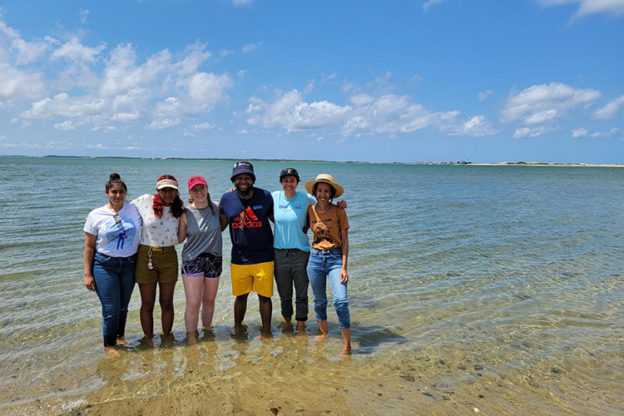By Anna Cass
On a recent July day, Mass Audubon’s five Environmental Fellows and four of the Coastal Resilience Program (CRP) Interns met at Long Pasture Wildlife Sanctuary in Barnstable to learn more about coastal habitats.

Learning from an expert
There was plenty of interesting wildlife at work as we toured along the path around the nature center. A memorable highlight: Purple Martins flying home with dragonflies clutched in their beaks. Their nests were fascinating, human-made boxes built to address the birds’ habitat loss.
As we turned our heads away from the birds and out towards the coast, Coastal Resilience Program Director Dr. Danielle Perry shared her expertise on the salt marsh landscape. She explained how just two inches in sea level rise alters the environment below the soil and sand. These changes are enough to make the area uninhabitable for the existing species of grasses and cause entirely different species of plants to take root.
“What stuck with me most was the scale of change we could observe across different lengths of time,” Land Conservation Fellow Jovan Bryan said. “From the long-term process of sand being migrated to Sandy Neck to the biodiversity emerging with the shifting daily tide, and especially the changes in vegetation from the rising sea level.”
A break for lunch
Knowledge sharing and connection are core goals of the Coastal Resilience Program Internship and the Environmental Fellowship Program. The whole group ate lunch together and discussed the projects we were working on in our respective roles, and what led us to the environmental field.
This trip also created opportunities for fellows and interns to learn about different career paths, such as those of Danielle and Cape Cod Adult Programs Coordinator Sean Kortis. Conservation Science Fellow Amara Chittenden felt it was beneficial to talk to other professionals in the environmental field.

“I really enjoyed talking to Sean about the Field Naturalist program that Mass Audubon offers,” she said. “A goal of mine is to be able to read the landscape like they can, with the ability to make inferences about an environment by knowing the history of the earth and wildlife at that place.”
Looking for Wildlife
The afternoon afforded hands-on experience in the salt marsh, wandering through the grasses, wading in the water, and asking questions about the different specimens we found.

Sean taught the group to use smell to determine whether a discarded crab shell came from a recent molting or if the crab has died: If the crab has molted, there will be no decomposing matter inside it. If the crab has died for some reason, the scent reveals processes of decomposition at work.
Shells weren’t the only interesting find near the water. A family nearby alerted us to a horseshoe crab burrowing in a watery divot in the sand. Sean carefully flipped over the animal to reveal the structure underneath the shell. After we observed its fascinating “pusher legs,” well designed to help the animal burrow in the sediment, it was time to bring it back to the water.
Policy & Advocacy Fellow Isabela Chachapoyas-Ortiz gently carried the horseshoe crab into the ocean. “Not only did I have the opportunity to explore the delicate coastal ecosystems that we need to protect, but I got to hold a horseshoe crab and return it to its home,” she said.
We spent the rest of the afternoon skipping rocks and asking questions about other wildlife we found at our feet. Razor Clams, Green Crabs, and Pickleweed became temporary celebrities as the group explored.

Everyone was tired as we walked back to the nature center after a long day in the sun. There was an air of satisfaction as people chatted about what they had learned. Opportunities to meet and learn from professionals in the conservation and environmental fields are a keystone of the EFP, and the group was eager to discuss ideas for future trips.
Luckily, the group need not wait long. Trips, trainings, and professional development are staples in the calendar of an Environmental Fellow.
Learn more about the Environmental Fellowship Program or support our early careers programs.
Anna Cass is the Marketing & Communications Environmental Fellow. She will be documenting the experiences of all the fellows throughout the year.


